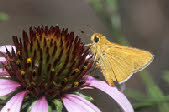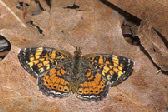The Butterflies of the World Foundation
A Non-





Battus philenor, Lexington Wildlife Management Area, Cleveland County, Oklahoma,
12 August 2008 Ref
#: I-
Pipevine Swallowtail
Battus philenor Linnaeus, 1771
Subfamily Papilioninae
Tribe Troidini, Aristolochia Swallowtails
Taxonomy
There are about 600 species within the family Papilionidae. The family is made up of 3 subfamilies, the Parnassiinae, which has about 50 species of Parnassians and Apollos that are found mostly in the montane regions of the nothern hemisphere, the Baroniinae, which has only 1 species, Baronia brevicomis from western Mexico, and the Papilioninae, which has about 550 species found worldwide. The subfamily Papilioninae is further divided into 4 tribes, the Teinopalpini, which include 2 species from the Himalayas, the Leptocircini, which has about 140 species and includes kite Swallowtails, the Papilionini, which has over 200 worldwide species and includes the fluted swallowtails, and the Troidini, which has about 130 worldwide species including the birdwings as well as the Aristolochia Swallowtails in which Battus philenor belongs to.

Battus philenor, Lexington Wildlife Management Area, Cleveland County, Oklahoma,
2 October 2005 Ref
#: I-

Battus philenor, Ouachita National Forest, Cedar Lake, Le Flore County, Oklahoma,
28 June 2010 Ref
#: I-

Battus philenor, Ouachita National Forest, Cedar Lake, Le Flore County, Oklahoma,
28 June 2010 Ref
#: I-

Battus philenor, Ouachita National Forest, Beech Creek, Le Flore County, Oklahoma,
28 June 2010 Ref
#: I-

Battus philenor, Ouachita National Forest, Cedar Lake, Le Flore County, Oklahoma,
28 June 2010 Ref
#: I-

Battus philenor, Ouachita National Forest, Beech Creek, Le Flore County, Oklahoma,
28 June 2010 Ref
#: I-

Battus philenor, Ouachita National Forest, Beech Creek, Le Flore County, Oklahoma,
28 June 2010 Ref
#: I-

Battus philenor, Ouachita National Forest, Cedar Lake, Le Flore County, Oklahoma,
28 June 2010 Ref
#: I-

Battus philenor, The Heard Natural Science Museum and Wildlife Sanctuary, Denton
County, Texas, 29 July 2009 Ref
#: I-

Battus philenor, Lexington Wildlife Management Area, Cleveland County, Oklahoma,
17 August 2009 Ref
#: I-
General Information:
Battus philenor is a common dark swallowtail found in the southern United States
in a variety of open habitats usually near deciduous woodlands. It avidly collects
nectar and is a common garden visitor. Males can also be found in numbers imbibing
minerals from the edges of lakes, rivers, and puddles on gravel roads. Battus philenor
caterpillars eat noxious pipevines and sequester toxic chemicals from them which
persist into adulthood, eggs and pupae. These chemicals make the butterfly very
distasteful to predators and many other species mimic this butterfly in order to
gain protection. These other species include the Spicebush Swallowtail, the female
Black Swallowtail, black morph of the Eastern Tiger Swallowtail, the Red-
Lifecycle:
Larval hostplants include pipevines. Some of the more common are Dutchman’s Pipe and Virginia Snakeroot. Larvae consume the entire plant.

All photographs, artwork, text and website design are the property of The Butterflies of the World Foundation (unless otherwise stated) and are protected under national and international copyright laws. Photographs, artwork or text on this website may not be reproduced in any way without prior written consent of The Butterflies of the World Foundation.

Woolly Pipevine, Aristolochia tomentosa, a common larval food plant, Lexington Wildlife
Management Area, Cleveland County, Oklahoma F-

Battus philenor, larva with osmeterium partially everted, on Woolly Pipevine, Aristolochia
tomentosa, Lexington Wildlife Management Area, Cleveland County, Oklahoma, 12 May
2012 Ref
#: I-

Battus philenor, larva on Woolly Pipevine, Aristolochia tomentosa, Lexington Wildlife
Management Area, Cleveland County, Oklahoma, 12 May 2012 Ref #: I-

Battus philenor, larva on Woolly Pipevine, Aristolochia tomentosa, Lexington Wildlife
Management Area, Cleveland County, Oklahoma, 12 May 2012 Ref #: I-

Battus philenor, larva on Woolly Pipevine, Aristolochia tomentosa, Lexington Wildlife
Management Area, Cleveland County, Oklahoma, 9 May 2012 Ref #: I-

Battus philenor, larvae on Woolly Pipevine, Aristolochia tomentosa, Lexington Wildlife
Management Area, Cleveland County, Oklahoma, 9 May 2012 Ref #: I-

Battus philenor, larva on Woolly Pipevine, Aristolochia tomentosa, Lexington Wildlife
Management Area, Cleveland County, Oklahoma, 12 May 2012 Ref #: I-

Battus philenor, larva on Woolly Pipevine, Aristolochia tomentosa, Lexington Wildlife
Management Area, Cleveland County, Oklahoma, 12 May 2012 Ref #: I-

Battus philenor, larva on Woolly Pipevine, Aristolochia tomentosa, Lexington Wildlife
Management Area, Cleveland County, Oklahoma, 9 May 2012 Ref #: I-

Battus philenor, larva with osmeterium partially everted, on Woolly Pipevine, Aristolochia
tomentosa, Lexington Wildlife Management Area, Cleveland County, Oklahoma, 12 May
2012 Ref
#: I-

Battus philenor,exhibiting mud-

Battus philenor,exhibiting mud-

Battus philenor, Lexington Wildlife Management Area, Cleveland County, Oklahoma,
10 August 2008 Ref
#: I-

Battus philenor, Lexington Wildlife Management Area, Cleveland County, Oklahoma,
10 August 2008 Ref
#: I-

Battus philenor,exhibiting mud-